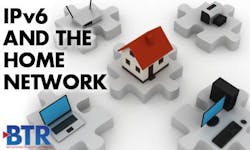IPv6, Home Networking Increasingly Intertwined
IPv6 and advanced home networking are perceived as occupying two sides of the cable industry's to-do list: The new addressing scheme is a chore that has to be done to maintain the health of operators' broadband businesses. It is not thought of as a direct revenue generator. Conversely, advanced home networks are seen as a future platform that will directly lead to extraordinarily profitable services such as home automation and tele-health.The two no longer exist on such different planes. The final frontier for IPv6 is in the home. There, it will be a very real and direct key to providing enough IP addresses to support what is expected to be an explosion of home networking services. Thus, though IPv6's technical status hasn't changed, it now is more directly tied to potential revenue.The Internet of Things, as it is called, needs two things that IPv6 provides: Enough addresses and the ability for direct connectivity between end points. "IPv4 can't support connectivity for all the devices on the Internet," said John Brzozowski, a Comcast (NASDAQ:CMCSA) Fellow and the MSO's chief IPv6 architect. "We are [supplementing] IPv4 and creating the potential for end-to-end reachability."It's an accepted fact that the cable home of the future will be a complex thing. This is true on many levels - including addressing schemes. The cable industry has settled on the dual stack approach to Internet addressing. In short, for the foreseeable future - indeed, likely decades into the future - cable operators will operate parallel IPv4 and IPv6 networks. That approach is accepted as being the simplest. Experts say that this doesn't change when the final frontier - the home - is reached.It is, however, a potentially tricky proposition for operators who don't prepare. Engineering staffs must recognize that homes will for decades be a mix of end user equipment - consumer electronics and computing gear - that just runs IPv4 and devices that run both addressing protocols.The IPv4 portion of the networks still will sit behind a network address translation (NAT) device, while the IPv6 element of the network will be protected by a firewall, Brzozowski said. Comcast has been experimenting with IPv6-based home networks for about a year.Bringing IPv6 to home networks poses no insurmountable obstacle. It's theoretically an extension of dual stack in other network segments. That said, it clearly requires careful planning. The trickiest element will extend to the minority of MSOs in which home gateway and router functionality is owned by the subscriber and thus is not integrated with DOCSIS functionality.Some older, consumer-purchased wireless equipment won't support IPv6. A minority of those devices won't be capable of accepting software or firmware upgrades enabling them to do so. If this antiquated equipment is in homes in which subscribers expect sophisticated IPv6-enabled networking, the operator may have dissatisfied customers on its hands.This requires attention, but is not the end of the world, said Charles Moreman, a principal engineer with Cisco(NASDAQ:CSCO). "There may be devices deployed years ago by cable operators from any number of vendors that need to be upgraded or, if they are very old, replaced," he said. "That's just part of the basic blocking and tackling" of rolling out new services.That seems like a manageable problem and, according to experts, a good example of why most have decided to move to devices in which the DOCSIS router and gateway functions are in some way integrated. The basic premise is that removing subscribers as much as possible from the equation is an increasingly good ideas as home networks grow more sophisticated.Even newer equipment, if not centrally managed by the cable operation, could cause problems. Stephen Palm, a senior technical director in Broadcom's (NASDAQ:BRCM) broadband communications group, suggested that care must be taken even if consumer gear is new. Essentially, checking the box on the management console that says "Enable IPv6" or a similar term could have unintended consequences. "My fear is that dual stack systems that have been implemented in a less than mass produced way may misbehave or do funny addressing things," said Palm.Palm added that one benefit of the new IEEE 1905 protocol is that it can provide useful information at the layer 2 - the data link layer - of the Open Systems Interconnect (OSI) model. Thus, even an IP network that is not functioning can provide valuable feedback to network operators.None of these problems appears insurmountable. It is important to remember, however, that sophistication - and the challenges that accompany it - will grow over time. Comcast sees a day when a home will look a bit like an enterprise. Brzozowski said subnets could be established for entertainment, guests, the kids, home security, telehealth, home automation, the home office and other specific groups or functions. This is very promising - but strongly suggests a high level of sophistication and planning.The complexity extends ever further. In response to emailed questions, Victor Kuarsingh, Rogers' (TSE:RCI) senior architect for IP Networks, noted the need to support multiscreen initiatives. "The requirement for supporting a legacy base of IPv4 is not just confined to the standard home network, but also to mobile network environments," Kuarsingh wrote. "An example of this would include a common mode of operation where a subscriber tethers their Internet connection on a smartphone to share with nearby devices."Carl Weinschenk is the Senior Editor of Broadband Technology Report. Contact him at [email protected].
